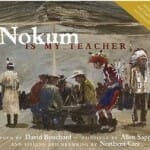 Reluctant readers are found in every classroom. David Bouchard, a Canadian Métis author and literacy advocate, skillfully addresses this issue in his award winning book, Nokum is my Teacher. The uniqueness of this book lies in the dual text. The left column is in English while the right column includes Cree sentences. A YouTube version of the book is available at http://www.youtube.com/watch?v=17QYnw5xzWE.
Reluctant readers are found in every classroom. David Bouchard, a Canadian Métis author and literacy advocate, skillfully addresses this issue in his award winning book, Nokum is my Teacher. The uniqueness of this book lies in the dual text. The left column is in English while the right column includes Cree sentences. A YouTube version of the book is available at http://www.youtube.com/watch?v=17QYnw5xzWE.
Tucked into the book jacket is a supplementary audio recording. The CD includes both languages with original aboriginal music performed by the drumming group Northern Cree. This Canadian aboriginal group has received multiple Grammy nominations and has been awarded several Native American Music Awards and Canadian Aboriginal Music Awards. Their founder’s motto was “If you believe in yourself, who you are, where you come from, your culture and more importantly your language, it will take you to places you never even dreamed of.”
The running verse is between a boy and his grandmother or nokum. He continually questions whether Canadian ways should supersede his native culture. In particular, he focuses on reading and the books that pertain to the outside world. Without any reservation, the boy asks why his grandmother and others did not learn to read. The boy wants to know why his elders “don’t practice what they preach.” The calming response of the grandmother forces the boy to reexamine his situation. She candidly asks, “Would you ask all of these questions had I learned to read when I was young?”
The reader is left wondering to what extent subcultures should integrate into society. At one point, the boy states, “But why must we fit in their world? Our lives are fine out here!” After that the grandmother reminds him of the importance of sharing. This gentle nudge allows the boy to reach the conclusion that reading is important.
The give and take dialogue allows the reader to see the special relationship between the boy and his grandmother. It is unclear whether the grandmother is actually present or whether her voice is merely spiritual. Regardless, the boy solved his dilemma through a friendly conversation with his beloved grandmother.
The illustrations are paintings by the notable artist, Allen Sapp, a Saskatchewan who was raised on the Red Pheasant Reserve. His artwork focuses on the relationship with his grandmother. The illustrations in the book include traditional customs and modern life. Nature and winter scenes are dominant features.
Awards
- Anskohk Aboriginal Literature Festival Winner, Children’s Book of the Year 2007
- Moonbeam Children’s Book Awards, 2007 Bronze Medalist- multicultural picture book category
- Alberta Children’s Book of the Year nominee 2007
- Canadian Children’s Book Centre Our Choice, 2009
- In 2009, Bouchard became a member of the Order of Canada “for his contributions as an author of children’s books and an advocate who has championed the cause of reading and writing, and who has shared his pride as a member of the Métis community through his stories.”
Discussion topics
- The positive attributes of reading
- Family relationships- child and grandparent
- Conformity vs. maintaining one’s traditions
- Assimilation- pros and cons
- Recognizing individual differences- cultural diversity
- Native American history, music, and art
- Cree traditions
Question
- Can you share ways that you have used this book in your classroom?
Leave a Reply
You must be logged in to post a comment.